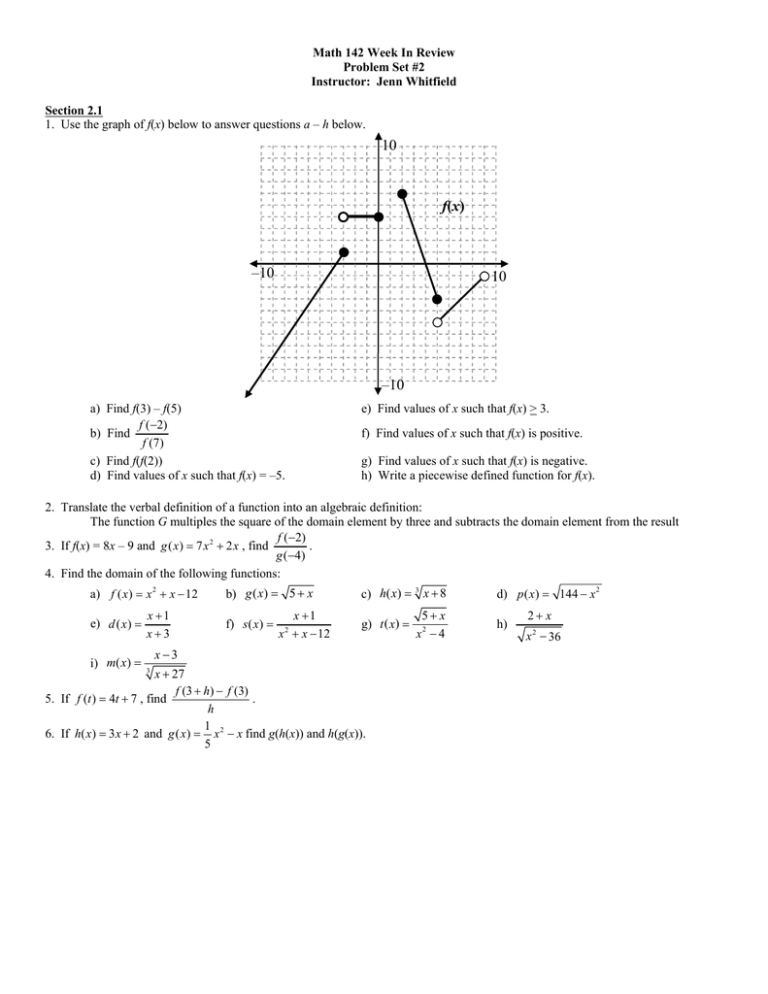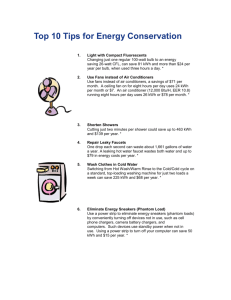10
advertisement

Math 142 Week In Review Problem Set #2 Instructor: Jenn Whitfield Section 2.1 1. Use the graph of f(x) below to answer questions a – h below. 10 f(x) –10 10 –10 a) Find f(3) – f(5) f (−2) b) Find f (7) c) Find f(f(2)) d) Find values of x such that f(x) = –5. e) Find values of x such that f(x) > 3. f) Find values of x such that f(x) is positive. g) Find values of x such that f(x) is negative. h) Write a piecewise defined function for f(x). 2. Translate the verbal definition of a function into an algebraic definition: The function G multiples the square of the domain element by three and subtracts the domain element from the result f (−2) . 3. If f(x) = 8x – 9 and g ( x ) = 7 x 2 + 2 x , find g (−4) 4. Find the domain of the following functions: a) f ( x ) = x 2 + x − 12 e) d ( x ) = i) m( x) = x +1 x+3 b) g ( x) = 5 + x f) s ( x) = x +1 x + x − 12 2 c) h( x) = 3 x + 8 g) t ( x) = x −3 x + 27 f (3 + h) − f (3) . 5. If f (t ) = 4t + 7 , find h 1 6. If h( x) = 3x + 2 and g ( x) = x 2 − x find g(h(x)) and h(g(x)). 5 3 5+ x x2 − 4 d) p ( x ) = 144 − x 2 h) 2+ x x 2 − 36 Section 2.2 7. Below is a graph of g(x). Use it to graph the functions below. 5 g(x) –5 5 –5 a) g ( x + 1) b) g(x) + 3 c) 2g(x) d) 2g(x + 1) + 3 8. Indicate verbally how the graph of f ( x ) = −( x − 4) 2 + 3 is related to the graph of f ( x ) = x 2 . 9. The graphs below are results of transformations of one of the six basic functions listed in the textbook. Identify the basic function and describe the transformation verbally. Write an equation for the given graph. a) b) 10 20 g(x) f(x) –10 10 –5 –20 –10 ⎧5 + 0.5 x 10. Graph h( x) = ⎨ ⎩ −10 + 2 x 5 0 ≤ x <10 x ≥ 10 11. The table below show the electricity rates charged by Better than Lighting Utilities in the winter months. a) Write a piecewise definition of the monthly charge W(x) for a customer who used x kWh in a winter month. b) Find the monthly charge for a customer who uses 550 kWh. Winter (November – June) Base Charge $8.00 First 400 kWh or less at $0.0750 per kWh Over 400 kWh at 0.0950 per kWh. Section 2.3 12. Find the intercepts, vertex, maximum or minimum, and the range. a) m( x ) = x 2 + 3 x − 10 b) s ( x ) = −5 x 2 − 40 x − 75 13. For the equation graphed below, find the intercepts, the vertex, the maximum or minimum, the range, increasing intervals, decreasing intervals, intervals where the function is positive, and intervals where the function is negative. Then find the equation of the function. 10 g(x) –10 10 –10 14. The table gives the price, in dollars, of a round-trip ticket from Dallas to New York on a certain airline and the corresponding monthly profit, in million of dollars, for that airline 200 250 300 350 400 450 ticket price ($) Profit (millions 12 13.8 14.7 15.1 14.5 12.7 of $) a) Find the quadratic regression model that gives profit as a function of the ticket price. b) Based on this model, what price will give the largest profit? 15. The marketing and research department for a company that manufactures and sells memory chips for microcomputers established the following price-demand function p( x) = 75 − 3x where p(x) is the wholesale price in dollars at which x million chips can be sold. In addition, the company found it’s cost function to be C ( x) = 125 + 6 x where x is in millions of chips and C(x) is in millions of dollars. a) Find the company’s Revenue function. b) Find the company’s Profit function. c) Find the output that will produce the maximum revenue. What is the maximum revenue? d) What is the wholesale price per chip (to the nearest dollar) that produces the maximum revenue? e) Find the break-even point(s) to the nearest thousand chips. d) For what outputs will a loss occur? A profit? 16. Find the x and y intercepts for the rational functions below. x 2 − x − 20 x2 − 9 x+5 = y b) y = c) a) y = x+3 x+8 x2 − 4






